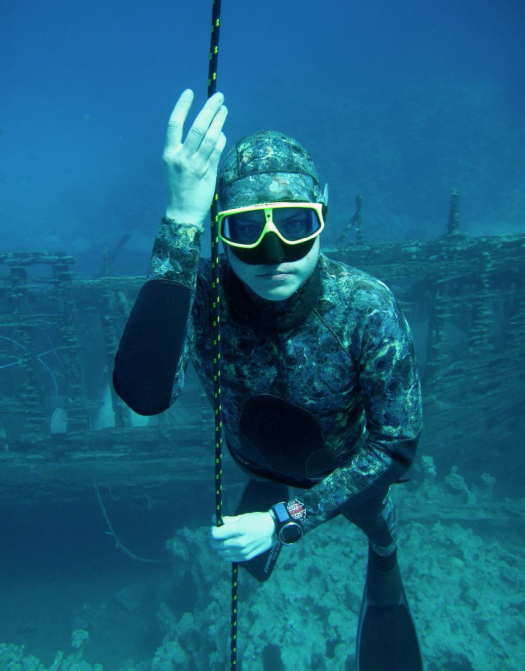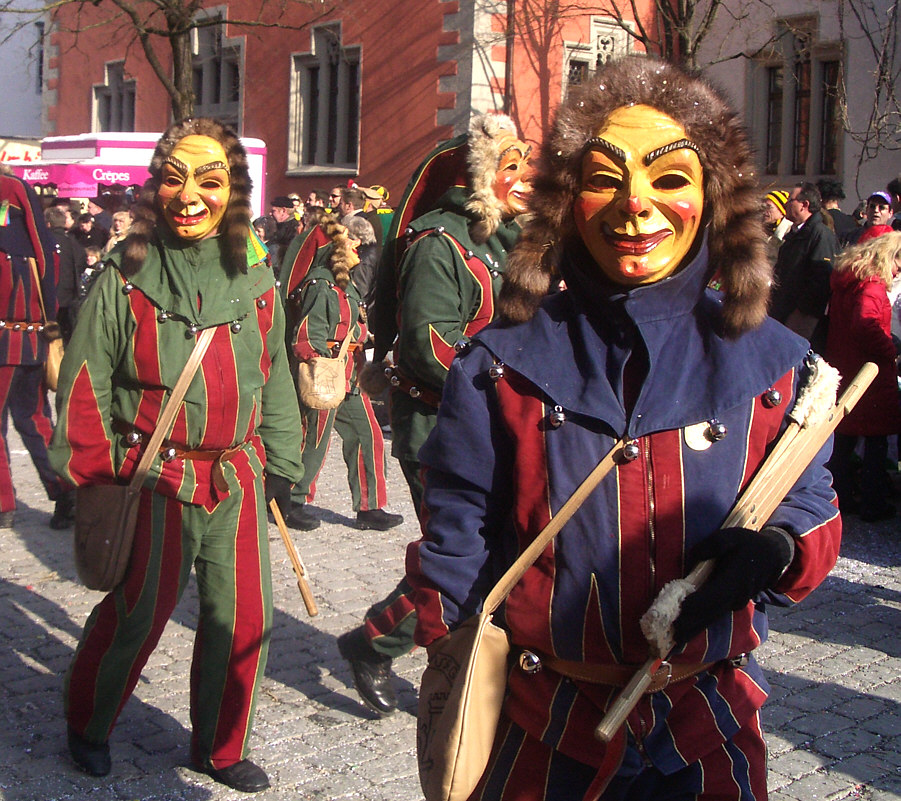|
Skandalopetra
diving () dates from ancient Greece, when it was used by sponge fishermen, and has been re-discovered in recent years as a freediving discipline. It was in this discipline that the first world record in freediving was registered, when the Greek sponge fisherman Stathis Chantzis dived to a depth of 83 m (272 ft) in July 1913. It consists of a variable ballast dive using a tied to a rope. A companion on a boat recovers the diver by pulling the rope up after the descent, and keeps a watch on the diver from the surface. Origins A skandalopetra dive known to contemporary divers is that of Stathis Chantzis, a Greek sponge fisherman. On 14 July 1913, in the Karpathos port, Chantzis recovered the lost anchor of the Regina Margherita, a ship of the Italian Navy, at the depth of 83 m. His feat is considered the first depth record in apnea diving. The , or simply (), is a stone, usually of marble or granite, weighing between 8 and 14 kg, with rounded corners and hydrodynamic shape. ... [...More Info...] [...Related Items...] OR: [Wikipedia] [Google] [Baidu] |
History Of Underwater Diving
The history of underwater diving starts with freediving as a widespread means of hunting and gathering, both for food and other valuable resources such as pearls and coral. By classical Greek and Roman times commercial applications such as sponge diving and marine salvage were established. Military diving also has a long history, going back at least as far as the Peloponnesian War, with recreational and sporting applications being a recent development. Technological development in ambient pressure diving started with stone weights (skandalopetra) for fast descent. In the 16th and 17th centuries diving bells became functionally useful when a renewable supply of air could be provided to the diver at depth, and progressed to surface-supplied diving helmets—in effect miniature diving bells covering the diver's head and supplied with compressed air by manually operated pumps—which were improved by attaching a waterproof suit to the helmet and in the early 19th century became ... [...More Info...] [...Related Items...] OR: [Wikipedia] [Google] [Baidu] |
Freediving
Freediving, free-diving, free diving, breath-hold diving, or skin diving, is a mode of underwater diving that relies on breath-holding until resurfacing rather than the use of breathing apparatus such as scuba gear. Besides the limits of breath-hold, immersion in water and exposure to high ambient pressure also have physiological effects that limit the depths and duration possible in freediving. Examples of freediving activities are traditional fishing techniques, competitive and non-competitive freediving, competitive and non-competitive spearfishing and freediving photography, synchronised swimming, underwater football, underwater rugby, underwater hockey, underwater target shooting and snorkeling. There are also a range of "competitive apnea" disciplines; in which competitors attempt to attain great depths, times, or distances on a single breath. Historically, the term ''free diving'' was also used to refer to scuba diving, due to the freedom of movement compared wi ... [...More Info...] [...Related Items...] OR: [Wikipedia] [Google] [Baidu] |
Sponge Diving
Sponge diving is underwater diving to collect soft natural sponges for human use. Background Most sponges are too rough for general use due to their structural spicules composed of calcium carbonate or silica. But two genera, '' Hippospongia'' and '' Spongia'', have soft, entirely fibrous skeletons. These two genera are most commonly used by humans. It is unknown when exactly the sponge became an article of use. In Ancient Greek writings, Homer and Plato mentioned the sponge as an object used for bathing. Through trading, Europeans used soft sponges for many purposes including padding for helmets, portable drinking utensils and municipal water filters. Until the invention of synthetic sponges, they were used as cleaning tools, applicators for paints and ceramic glazes, and discreet contraceptives. However, by the mid-20th century, over-fishing had brought both the animals and the industry close to extinction. Many objects with sponge-like textures are now made of substances n ... [...More Info...] [...Related Items...] OR: [Wikipedia] [Google] [Baidu] |
Noseclip
A noseclip or nose clip is a device designed to hold the nostrils closed to prevent water from entering, or air from escaping, by people during aquatic activities such as kayaking, freediving,Umberto Pelizzari, Pelizzari, Umberto & Tovaglieri, Stefano (2001) ''‘Manual of Freediving: Underwater on a single breath’'', English translation 2004 by Idelson-Gnocchi Ltd., Reddick, FL; swimming, synchronized swimming and waterdance. A nose clip is generally made of plastic or of wire covered in rubber or plastic. Nose clips may also have a long band to keep the clip around the neck while it is not being used or a cord to attach the nose clip to goggles or kayaking helmet. See also * Nasal strip References Synchronized swimming Canoeing and kayaking equipment Fishing equipment {{Swimming-stub ... [...More Info...] [...Related Items...] OR: [Wikipedia] [Google] [Baidu] |
Underwater Diving Procedures
An underwater environment is a environment of, and immersed in, liquid water in a natural or artificial feature (called a body of water), such as an ocean, sea, lake, pond, reservoir, river, canal, or aquifer. Some characteristics of the underwater environment are universal, but many depend on the local situation. Liquid water has been present on Earth for most of the history of the planet. The underwater environment is thought to be the place of the origin of life on Earth, and it remains the ecological region most critical to the support of life and the natural habitat of the majority of living organisms. Several branches of science are dedicated to the study of this environment or specific parts or aspects of it. A number of human activities are conducted in the more accessible parts of the underwater environment. These include research, underwater diving for work or recreation, and underwater warfare with submarines. It is hostile to humans in many ways and often inaccessi ... [...More Info...] [...Related Items...] OR: [Wikipedia] [Google] [Baidu] |
No-limits Apnea
No-limit apnea is a discipline of competitive freediving, also known as competitive apnea, in which the freediver descends and ascends with the method of his or her choice. Often, a heavy metal bar or "sled" grasped by the diver descends fixed to a line, reaching great depths. The most common ascension assistance is via inflatable lifting bags or vests with inflatable compartments, which allow for rapid surfacing. The dives may be performed head-first or feet-first. This form of diving is considered extremely dangerous by diving professionals. No-limit apnea has claimed the lives of several divers. In 2025 the discipline is not recognized by either AIDA or CMAS. Challenges The three main differences between free diving disciplines that involve diving to depth and those that occur at the surface are that you cannot interrupt the dive, there are periods where work is performed and the diver is impacted by direct effects of pressure. Records The current no-limit world record holde ... [...More Info...] [...Related Items...] OR: [Wikipedia] [Google] [Baidu] |
AIDA International
Association Internationale pour le Développement de l'Apnée (AIDA) (English: ''International Association for the Development of Apnea'') is a worldwide rule- and record-keeping body for competitive breath holding events, also known as freediving. It sets standards for safety, comparability of Official World Record attempts and freedive education. AIDA International is the parent organization for national clubs of the same name. AIDA World Championships are periodically held. History AIDA was founded on November 2, 1992, in Nice, France, by Frenchmen Roland Specker, Loïc Leferme and Claude Chapuis, with Specker as its first president. The AIDA Competitions started to take form in 1993. National clubs begin to form over all Europe in 1994–1995. AIDA became AIDA International in 1999. * In 1999 Sébastien Nagel, of Switzerland, replaced Roland Specker as the president. * Bill Strömberg, of Sweden, replaced Sébastien Nagel as president in 2005. * Kimmo Lahtinen, of Finland ... [...More Info...] [...Related Items...] OR: [Wikipedia] [Google] [Baidu] |
Fins
A fin is a thin component or appendage attached to a larger body or structure. Fins typically function as foil (fluid mechanics), foils that produce lift (force), lift or thrust, or provide the ability to steer or stabilize motion while traveling in water, air, or other fluids. Fins are also used to Fin (extended surface), increase surface areas for heat transfer purposes, or simply as ornamentation. Fins first evolved on fish as a means of locomotion. Fish fins are used to generate thrust and control the subsequent motion. Fish and other aquatic animals, such as cetaceans, actively propel and steer themselves with pectoral fin, pectoral and Caudal fin, tail fins. As they swim, they use other fins, such as dorsal fin, dorsal and anal fins, to achieve stability and refine their maneuvering.Helfman G, Collette BB, Facey DE and Bowen BW (2009"Functional morphology of locomotion and feeding" Chapter 8, pp. 101–116. In:''The Diversity of Fishes: Biology'', John Wiley & Sons. . The ... [...More Info...] [...Related Items...] OR: [Wikipedia] [Google] [Baidu] |
Mask
A mask is an object normally worn on the face, typically for protection, disguise, performance, or entertainment, and often employed for rituals and rites. Masks have been used since antiquity for both ceremonial and practical purposes, as well as in the performing arts and for entertainment. They are usually worn on the face, although they may also be positioned for effect elsewhere on the wearer's body. In art history, especially sculpture, "mask" is the term for a face without a body that is not modelled in the round (which would make it a "head"), but for example appears in low relief. Etymology The word "mask" appeared in English in the 1530s, from Middle French ''masque'' "covering to hide or guard the face", derived in turn from Italian ''maschera'', from Medieval Latin ''masca'' "mask, specter, nightmare". This word is of uncertain origin, perhaps from Arabic ''maskharah'' مَسْخَرَۃٌ "buffoon", from the verb ''sakhira'' "to ridicule". However, it ... [...More Info...] [...Related Items...] OR: [Wikipedia] [Google] [Baidu] |
Wetsuit
A wetsuit is a garment worn to provide thermal protection while wet. It is usually made of foamed neoprene, and is worn by surfers, divers, windsurfers, canoeists, and others engaged in water sports and other activities in or on the water. Its purpose is to provide thermal insulation and protection from abrasion, ultraviolet exposure, and stings from marine organisms. It also contributes extra buoyancy. The insulation properties of neoprene foam depend mainly on bubbles of gas enclosed within the material, which reduce its ability to conduct heat. The bubbles also give the wetsuit a low density, providing buoyancy in water. Hugh Bradner, a University of California, Berkeley, physicist, invented the modern wetsuit in 1952. Wetsuits became available in the mid-1950s and evolved as the relatively fragile foamed neoprene was first backed, and later sandwiched, with thin sheets of tougher material such as nylon or later spandex (also known as lycra). Improvements in the way ... [...More Info...] [...Related Items...] OR: [Wikipedia] [Google] [Baidu] |
Ancient Greece
Ancient Greece () was a northeastern Mediterranean civilization, existing from the Greek Dark Ages of the 12th–9th centuries BC to the end of classical antiquity (), that comprised a loose collection of culturally and linguistically related city-states and communities. Prior to the Roman period, most of these regions were officially unified only once under the Kingdom of Macedon from 338 to 323 BC. In Western history, the era of classical antiquity was immediately followed by the Early Middle Ages and the Byzantine period. Three centuries after the decline of Mycenaean Greece during the Bronze Age collapse, Greek urban poleis began to form in the 8th century BC, ushering in the Archaic period and the colonization of the Mediterranean Basin. This was followed by the age of Classical Greece, from the Greco-Persian Wars to the death of Alexander the Great in 323 BC, and which included the Golden Age of Athens and the Peloponnesian War. The u ... [...More Info...] [...Related Items...] OR: [Wikipedia] [Google] [Baidu] |
Sponge
Sponges or sea sponges are primarily marine invertebrates of the animal phylum Porifera (; meaning 'pore bearer'), a basal clade and a sister taxon of the diploblasts. They are sessile filter feeders that are bound to the seabed, and are one of the most ancient members of macrobenthos, with many historical species being important reef-building organisms. Sponges are multicellular organisms consisting of jelly-like mesohyl sandwiched between two thin layers of cells, and usually have tube-like bodies full of pores and channels that allow water to circulate through them. They have unspecialized cells that can transform into other types and that often migrate between the main cell layers and the mesohyl in the process. They do not have complex nervous, digestive or circulatory systems. Instead, most rely on maintaining a constant water flow through their bodies to obtain food and oxygen and to remove wastes, usually via flagella movements of the so-called " collar ... [...More Info...] [...Related Items...] OR: [Wikipedia] [Google] [Baidu] |








